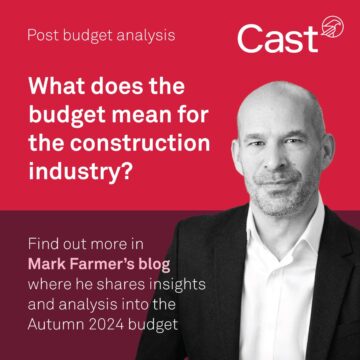As I write this, the sector is facing into one of it’s biggest periods of uncertainty in nearly 15 years. What about Covid 19 I hear some of you say. The reality is that although it was societally of huge consequence, the pandemic proved in many ways to have limited real impact on construction which in reality, with government support and some newly found leadership and collaboration, ended up continuing to operate succesfully during lockdown, especially in servicing a booming housing market.
What we are now facing into however seems much more serious and in some ways insidious in terms of the gradual fallout of events in the global and UK economy. The genesis of many of our growing current challenges was set back in 2022 as we endured the advent of conflict in Ukraine with resulting disruption to energy and supply chain markets and then a very home grown implosion of unprecedented and embarrassing UK political turmoil which in reality has only exarcebrated the economic consequences of what was already probably coming our way . The damage to consumer and money market confidence, the forced monetary policy consequences and more responsible but painful fiscal constraints are now starting to really bite as we see most construction sectors posting current and forward indicators showing reduced activity and new orders.
That trend is set to worsen as the new build housing market, for so long seemingly the economic safety net for the industry, is starting to reduce output in response to faltering housing market confidence and demand. In turn developers and investors are increasingly grappling with a perfect storm of lingering high construction costs, reduced development finance appetite and higher lending rates all combined with subdued confidence in their end demand markets of commercial and residential real estate. Commercial property is now struggling to decipher not just the ‘bricks to clicks’ shift but the implications on corporate occupier demand for offices in a post pandemic hybrid working world. The very recent downturn in US technology stocks is also further adding to woes and is already affecting demand for blue chip offices and fulfilment / logistics / hi tech manufacturing space.
In the public sector the Government’s usual and expected role – to act as a counter-cyclical stimulant for construction demand, is worryingly constrained as the public borrwing burden remains at historically high levels and there is little room for applying classic Keynesian economic theory. Although set piece national infrastructure projects such as HS2 appear to have survived the axe or cutbacks, major infrastructure programmes across school, prison and hospital building have all failed to build real traction, beset by a combination of lack of ministerial continuity and leadership but also a deteriorating value for money position as inflation undermines previous business case approvals and the public purse forces a resurgence of the need for ‘cheapness’.
In the part publicly funded housing association sector things are even more complicated. A combination of rent caps not keeping up with inflation, building safety legacy costs and more recently public scrutiny of the condition of existing building stock and related tenant health and welfare risks have all led to a reduced focus on new build development programmes relative to addressing existing stock under management. Any decline in the housing for sale market will also impact HA balance sheets as cross subsidy models come under pressure as they did post Global Financial Crisis. We have already seen an initial wave of financial viability downgrades from the Social Housing Regulator and I expect more.
Alongside a negative outlook for new build construction, the UK’s domestic repairs and maintenance sector is also likely to be seriously impacted as the cost of living crisis, declining housing values and disruption to pension annuities reduces net income or personal equity confidence and in turn the propensity to undertake house extension or refurbishment work. I expect the R&M sector to report significant contraction which in turn will affect materials supply chains and the business health of those SME’s who operate in this market. This will also reduce the ability to divert excess stocks of construction products and materials from new build or redeploy newly available labour capacity to operate in these markets.
“We are clearly in transition from opportunism to survivalism and that spells real danger for the industry’s clients as well as consultants, contractors, sub-contractors and manufacturers”
All in all, a depressing state of play for a sector which seems to constantly struggle, see-sawing from opportunism when times are good, which breeds hyper inflation and poor value for money, back to a dangerous, survivalist short termism with the increased risk of financial failure in a downturn. We are clearly in transition from opportunism to survivalism and that spells real danger for the industry’s clients as well as consultants, contractors, sub-contractors and manufacturers as I come onto below.
The last few years of seemingly relentless high demand across all construction sectors, even through Covid, are unfortunately coming to an end. In my discussions it would seem that large parts of the consulting and contracting markets still can’t or refuse to see it – perhaps influenced by the fact that they still seem busy. Tower cranes continue to dominate the skyline of many of our towns and cities, just as they did in 2008 / 2009. Most of that activity though relates to capex decisions committed to before more recent uncertainty. Any in depth discussion with ‘the money’ that fuels the private sector portion of our industry and which I talk to regularly and at length, will quickly lead you to the conclusion though that the biggest threat to demand although not immediately visible is the indecision in commitment to acquiring sites, progressing planning and procurement and most notably to any new start on site with physical construction or going beyond an in progress phased completion or natural hold point. Although markets are still liquid and a lot of cash is trying to find a home, a Mexican stand off seems to be developing between non distressed land and asset owners and developers and investors. Deal volumes have fallen markedly. There are plenty of deals being offered though on live or ‘good to go’ residential development opportunities, especially in the speculative developer sector which is already quickly looking to unload unsold stock to BTR investors. This doesn’t mean that they are all happening though or proceeding beyond due diligence. Most of the intelligent money is applying much more scrutiny and financial pencil sharpening to these deals compared to the last cycle. There is however clearly less distressed or forced deal volume in the market at the moment as unlike post GFC, development funding LTV’s are more sensible and risks of covenant breach have mostly been better managed. The longer the overall deal and viability impasse continues though, the greater the downstream impact on new build construction workload.
“The demographic ‘bow wave’, reduced labour mobility, societial shifts in younger generation employment and career aspirations and decades of under investment in skills and training are now going to create a future labour market squeeze the like of which we have never seen”
So, why do I think this downturn is so dangerous for construction compared to previous recessions? The brutal reality is that the longer term structural changes that have been creeping up on the industry for so long, and as warned in my 2016 report, Modernise or Die are now starting to really mainfest themselves. The demographic ‘bow wave’, reduced labour mobility, societial shifts in younger generation employment and career aspirations and decades of under investment in skills and training are now going to create an imminent labour market squeeze the like of which we have never seen. Before we get to that though we are going to enter at least a short term ‘mirage’ of easing labour pressure – tradespeople becoming available again, and at more reasonable rates as the self -employed market recalibrates to a reduced available workload. We will along the way lose even more people as we do in every downturn, those who will leave the industry disillusioned with its prospects. The property and construction professional sector is already seeing redundancies again, led by the front end of transactional agency but gradually working into the broader property and construction sector. This is the first time in over a decade we have seen this and it will potentially be more of an acute impact than previously as the unsustainable wage increases of recent years force quicker action to address cost base in the face of reducing workload and deal volumes.
All of this is ultimately likely to feed through to construction sites and force downward pressure on construction prices as the industry does what it has said it will never do again – race to the bottom. Some will hold their nerve but others will break ranks and start buying work – we are already seeing it in the tightening market of the last few months but it is currently still sporadic and it’s very difficult to predict spreads on some tenders or relativity to cost plan as sentiment is so volatile.
Any reduction in what in some instances have been clearly over inflated prices will be welcomed by clients and advisors but it still won’t be enough to correct the imbalance or lack of confidence in some appraisals. Don’t get me wrong, price rises over the last 12 months or so have been driven by huge and legitimate resource input cost pressures but we have also increasingly seen a fair share of ‘price the market’ premiums being applied in a busy market and you could say you can’t blame anyone for this as some businesses ‘make hay while the sun shines’. The reality is that construction tender price changes in our industry have decoupled from input costs over the last 40 years as increasingly opaque lump sum ‘D&B’ pricing has prevailed. Any significant real and sustainable reductions in construction prices ulitmately have to be funded from productivity and efficiency improvements. This is the Holy Grail that the industry has consistently failed to grapple with and achieve, mainly because it hasn’t really ever had to, it just rides the waves of economic cyclicality, passes off risk, alters it’s price point irrespective of real costs to secure workload and muddles through or goes bust. My contention however is that more and more jobs in the future will not be able to ‘muddle through’ and will no longer be physically or financially deliverable using this model due to declining labour resource security. This will lead to either increasingly severe cost, programme and quality delivery failure or unacceptable and unviable price premiums being paid to attract increasingly finite resource. We will in effect pay more and more for less and less.
“Against a backdrop of increasing regulatory pressure on decarbonisation, building safety, consumer protections and with the apparent low hanging fruit of increasingly disruptive technology solutions, the industry’s historic ‘labour before capital’ equation simply does not add up any more.”
The intervening short term mirage I talk about above in terms of recovering labour availability will also cause many to think our growing labour and skills crisis has gone away in the latter part of 2023 but this will be a big mistake. Once we return to growth, hopefully at some point in 2024, those businesses still reliant on the same, low productivity, analogue, labour intensive delivery models (across not just site trade labour but increasingly professsional and technical services) will struggle more than ever before to secure and train sufficient resource, underwrite the competency of that resource and in turn contract safely on the outcomes that employing that resource will lead to. That will in turn result in accelerating risk for consulting and contracting businesses and much increased exposure to resurgent wage led price inflation and poor quality, uncertain delivery. Against a backdrop of increasing regulatory pressure on decarbonisation, building safety, consumer protections and with the apparently ever more accessible low hanging fruit of disruptive technologies and processes, the industry’s historic ‘labour before capital’ equation simply does not add up any more.
“The basic fundamentals of our industry simply don’t work any more and clients are increasingly going to be forced, when they return to buying construction, to rethink how they engage with an industry not fit for purpose.”
Writing this blog I can assure you has been as depressing as you have no doubt found reading it but after many years of cajoling the industry to embrace modernisation and for government to play its part, I find this is just another opportunity to spell out some unwelcome facts but perhaps with an elevated sense of urgency. I have worked in the industry for over 30 years and have seen at least 2 major ‘hollowing out’ cycles as the sector contended with recessions in the early 1990’s and post GFC. This upcoming phase of the market feels more dangerous than ever though, even if the actual statistically defined GDP recesssion is short and shallow. The basic fundamentals of our industry simply don’t work any more and clients are increasingly going to be forced, when they return to buying construction, to rethink how they engage with an industry not fit for purpose. There will be the usual dogmatic retorts by those that say the industry will never change and doesn’t need to, that it is best suited to it’s current flexible imperfect model. They will say that mainstream industrialisation and technology adoption simply don’t work in a sector with the unique characteristics of construction. Most views however are informed by history and a backward looking view from periods when external factors were very different. The inflexion point we are awaiting is clearly when the risk of clients, funders, consultants and contractors doing nothing becomes greater than the perceived risk of doing something differently. In case you are in any doubt from what I have spent the last 6 or 7 years saying, I am explictly highlighting that it will be the failing labour market that forces this, it is just a matter of how quickly things further deteriorate.
Perhaps that inevitability, as I have repeatedly said, will be the reality check for the money and the clients who rely on using the construction industry. It is the demand side stakeholders that ultimately hold the ability to finally force construction towards a different place. Once they realise on a repetitive and consistent basis that doing what they have historically done threatens their own businesses then we might get action. That is not to decry the efforts of some notable pioneers in the supply chain who have not waited for their clients to ask but have unilaterally offered different and better solutions. By and large though such front runners have been unable to embed and scale up innovation as business as usual solutions. This will continue to be the case as long as their peer group competitors offer a seemingly more familiar ‘traditional’ option which clients and their advisors believe, hoping above hope, will create a better outcome. This will in my view increasingly be shown to be a path to further decline and ultimately business failure. 2023 I fear will be a widening of the fork in the road when it comes to making this choice.
Speaking personally, I remain committed to continuing to put my head above the parapet, to make a nuisance of myself and to help as many as I can do the right thing. Cast, enabled by our fantastic team, is also 100% committed to playing its part in continuing to innovate and change not just how we do business as a consultancy but also to helping our clients, whether policy makers, investors, developers or supply chain participants address the increasingly serious implications of my outlook above.
Mark Farmer, CEO, Cast Consultancy
January 2023






